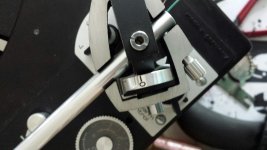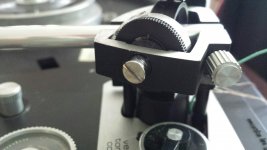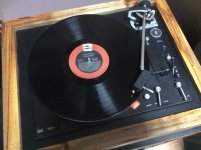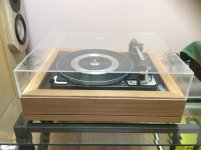Hello All....
I recently acquired a Dual 721 in generally great condition.
There is a problem with the spring housing(58). When I first received the turntable it was nigh impossible to move the knurled wheel to adjust the tracking force. It seems to be clamped tightly in place by bearing screw(60). If I back of the bearing adjustment very slightly to the point where the spring housing is able to be moved, the action of rotating the knurled wheel also rotates the bearing screw(60) and further loosens the bearings.
I disassembled, removed and replaced the spring housing and washer, making sure the helical spring engaged the frame. No improvement.
I almost always use a digital gauge and adjust tracking force via the counterweight on my turntables, so operationally it is no big deal, but I would like to fix it. Any ideas?
Thanks
Stay safe
Peter
I recently acquired a Dual 721 in generally great condition.
There is a problem with the spring housing(58). When I first received the turntable it was nigh impossible to move the knurled wheel to adjust the tracking force. It seems to be clamped tightly in place by bearing screw(60). If I back of the bearing adjustment very slightly to the point where the spring housing is able to be moved, the action of rotating the knurled wheel also rotates the bearing screw(60) and further loosens the bearings.
I disassembled, removed and replaced the spring housing and washer, making sure the helical spring engaged the frame. No improvement.
I almost always use a digital gauge and adjust tracking force via the counterweight on my turntables, so operationally it is no big deal, but I would like to fix it. Any ideas?
Thanks
Stay safe
Peter
Attachments
Looking at the blowup of your second picture and the large amount of wear on the adjuster slot force seems to have been used to adjust it .
I would suspect that a part is missing maybe a washer ? or the force used has damaged the mechanical operation but you say you replaced the spring housing and washer ?
Something is worn or broken or missing as the force of the screw should not slacken the bearing while allowing free movement of the adjustment wheel I would guess without the benefit of a parts blowup that there is a washer problem.
I would suspect that a part is missing maybe a washer ? or the force used has damaged the mechanical operation but you say you replaced the spring housing and washer ?
Something is worn or broken or missing as the force of the screw should not slacken the bearing while allowing free movement of the adjustment wheel I would guess without the benefit of a parts blowup that there is a washer problem.
I removed the spring housing and washer(they are the only parts), inspected and put them back, since they appeared to be fine. Prior to inserting the bearing screw,60, I checked that the helical spring was located in the frame and the housing returned when rotated a little.
The service manual says install and tighten screw 60 and then adjust the bearing from the other side of the frame. This is done, with the slightest amount of play. Arm tracks beautifully, but if I use the knurled wheel to adjust the tracking force, it loosens the screw 60 and bearing clearance gets excessive.
Yes, considerable force has damaged the bearing screw head. Looks like pliers were used too at some time.
I inspected the two bearings when I had it apart and they both looks good and square in the frame.
Thanks for the reply
Peter
The service manual says install and tighten screw 60 and then adjust the bearing from the other side of the frame. This is done, with the slightest amount of play. Arm tracks beautifully, but if I use the knurled wheel to adjust the tracking force, it loosens the screw 60 and bearing clearance gets excessive.
Yes, considerable force has damaged the bearing screw head. Looks like pliers were used too at some time.
I inspected the two bearings when I had it apart and they both looks good and square in the frame.
Thanks for the reply
Peter
The previous owner had the tonearm rewired, bringing the wires out the rear of arm tube, through the slot in the counterweight, so it may have been disassembled.
I am thinking that maybe the washer is not original and is too thick, causing a clamping action when the bearing screw is tightened. Just a thought. I assume that the shoulder of the bearing screw should bottom out in the counterbore of the frame.
I’ve since rerouted the wires properly.
I am thinking that maybe the washer is not original and is too thick, causing a clamping action when the bearing screw is tightened. Just a thought. I assume that the shoulder of the bearing screw should bottom out in the counterbore of the frame.
I’ve since rerouted the wires properly.
I have found a service manual but its in German my German is pretty basic is yours any better ?
Dual | Hifi Manuals Free: Service Manuals, Owners Manuals, Schematics online for free download
Dual | Hifi Manuals Free: Service Manuals, Owners Manuals, Schematics online for free download
It's a shame when someone previously putz's around with delicate tonearm pivot bearings/gimbels..... and uses wrong tools to perform their slop work.
I've seen this happen on many turntables though the years, particularly the Technics SL-1200's used by DJ's.
Leave the thing alone they should.... idiots.
These things are micro-precision adjusted assemblies, not some basement plumbing job.
I've seen this happen on many turntables though the years, particularly the Technics SL-1200's used by DJ's.
Leave the thing alone they should.... idiots.
These things are micro-precision adjusted assemblies, not some basement plumbing job.
This service manual is in English: https://www.google.com/url?sa=t&rct...Manual-2.pdf&usg=AOvVaw2X7r4wpuMpGyRAWK19irPW
Thanks guys. I have the service manual in English from vinylengine.com
Also posted there, but no response yet.
Everything else on the turntable functions beautifully other than the plastic start/stop lever which need to be addressed.
Tracks like a dream, came with a very nice Pickering xv15-1200e cartridge.
It’s uncanny how quiet the auto mechanism is. Makes my 1219 sound like a tractor.
I did away with the plastic base and put it in my recently fabricated
red maple plinth. Now to make a dust cover.
Stay safe,
Peter
Also posted there, but no response yet.
Everything else on the turntable functions beautifully other than the plastic start/stop lever which need to be addressed.
Tracks like a dream, came with a very nice Pickering xv15-1200e cartridge.
It’s uncanny how quiet the auto mechanism is. Makes my 1219 sound like a tractor.
I did away with the plastic base and put it in my recently fabricated
red maple plinth. Now to make a dust cover.
Stay safe,
Peter
Attachments
Thanks guys. I have the service manual in English from vinylengine.com
Also posted there, but no response yet.
Everything else on the turntable functions beautifully other than the plastic start/stop lever which need to be addressed.
Tracks like a dream, came with a very nice Pickering xv15-1200e cartridge.
It’s uncanny how quiet the auto mechanism is. Makes my 1219 sound like a tractor.
I did away with the plastic base and put it in my recently fabricated
red maple plinth. Now to make a dust cover.
Stay safe,
Peter
PJ, that wood base is just stunning!
Excellent job, did you make it?
And I like that grooved outer face, makes it stand out.
The mitered corners are my weak spot - I could never get them exact for some reason.
So I use butt jointing when doing a frame. - I need a better table saw blade.
My next door neighbor has a 701, in absolutely flawless cosmetic condition, serviced by me back in 2018. (he won't let anybody else touch his system)
Dead silent machine, and I always loved the Duals for their build quality.
My 1219 and 1229 were stolen from my old apartment back in 1983, I paid good money for those machines.
Thanks for the kind comments. Sad situation about the stolen turntables.
Yes, I made the plinth from a dead red maple tree that I felled last year. I enjoy woodworking and have made several for 1019, 1219, 1249 etc from oak, walnut and cedar. Mitre joints are alway finicky and it takes me a few passes on the table saw to get them perfect.
I find the idler wheel Duals benefit from the heavier base. I put rubberized damping inside this one, planning to use it with my 1219 which is presently residing in a cedar plinth.
Here’s a picture of my 1009sk in a cedar plinth with my home made dust cover, courtesy of Ace Hardware acrylic sheet and a smidgin of acetone. I’m working on improving my technique on the joints.
The plinths I don’t keep I sell on the auction site, with or without a restorable turntable that I fix up. Most buyers enjoy the distinctive look of a hand built plinth.
PS......acrylic sheet may be hard to source right now due to the demand for protection against the spread of Covid-19.
Yes, I made the plinth from a dead red maple tree that I felled last year. I enjoy woodworking and have made several for 1019, 1219, 1249 etc from oak, walnut and cedar. Mitre joints are alway finicky and it takes me a few passes on the table saw to get them perfect.
I find the idler wheel Duals benefit from the heavier base. I put rubberized damping inside this one, planning to use it with my 1219 which is presently residing in a cedar plinth.
Here’s a picture of my 1009sk in a cedar plinth with my home made dust cover, courtesy of Ace Hardware acrylic sheet and a smidgin of acetone. I’m working on improving my technique on the joints.
The plinths I don’t keep I sell on the auction site, with or without a restorable turntable that I fix up. Most buyers enjoy the distinctive look of a hand built plinth.
PS......acrylic sheet may be hard to source right now due to the demand for protection against the spread of Covid-19.
Attachments
PJ, that 1009's lookin' fine!
I'm impressed with your woodworking skills.... flabergasted even!
How do you join the corners?
Myself, I've used 3/4" x3/4" strips screwed and glued to lock the corners tight.
Asides from that, you're in NC, would you consider making things like that to ship to PA?
I don't do those online auction sites, never did.
I'm impressed with your woodworking skills.... flabergasted even!
How do you join the corners?
Myself, I've used 3/4" x3/4" strips screwed and glued to lock the corners tight.
Asides from that, you're in NC, would you consider making things like that to ship to PA?
I don't do those online auction sites, never did.
Me too! In fact, my flabber has never been so gasted!I'm impressed with your woodworking skills.... flabergasted even!

Wiseoldtech....this is a hobby, but I occasionally do small projects for others that appreciate the work.
Send me a PM if you have something in mind.
Send me a PM if you have something in mind.
From the description of what happens when you adjust the tracking force and the implied force needed to remove the screw with resulting damage, I would guess it originally had something like locktite/Cyanoacrylate applied to the screw to stop it backing out during adjustment?
just a thought....
regards
james
just a thought....
regards
james
Wiseoldtech....this is a hobby, but I occasionally do small projects for others that appreciate the work.
Send me a PM if you have something in mind.
Thanks a bunch.... will do! 🙂
Me too! In fact, my flabber has never been so gasted!
Perhaps doing more excersize will reduce some of that flabber. 😀
No, there isn't, or at least shouldn't. My 741Q has the same tonearm bearing assembly, it works flawlessly. Screw #60 doesn't need to be fastened that much that tools will leave severe markings like these. Bearing play is adjusted from the other side, using screw pin #49 and counter nut #48. There's some special tool available to drive this nut.From the description of what happens when you adjust the tracking force and the implied force needed to remove the screw with resulting damage, I would guess it originally had something like locktite/Cyanoacrylate applied to the screw to stop it backing out during adjustment?
As some previous owner yet has shown severe ignorance, for not to say idiocy, by routing the cabling out of the arm in the most inappropriate way (I'm scratching my head if the given length would even allow for that), he also might have put screw locking compound on screw #60's thread by whatever reason, or, as yet suspected, may have replaced washer #59 by an inappropriate one that locks the spring housing. The numbers are from the SM where you also find a cutaway view at page #13.
You've obeyed that tiny notch the spiral spring's end has to be locked into?
Best regards!
Last edited:
Kay,
Yes to the helical spring being engaged in the frame notch. I double checked by rotating the spring housing slightly prior to snugging the screw 60, and the spring tension returned it.
As I said previously the bearings look good under a magnifying glass and the tonearm tracks beautifully. I suspect that someone didn’t realize that the bearing screw 60 has a left hand thread, and was trying to undo the screw and caused the deformation in the slotted head.
I also thought that the washer may be a substitute for the correct one and is too thick.
Anyone have a spare washer that they can mic for me and I could lap this one down, if it is indeed too thick?
In the meantime, I’ll use my digital gauge for determining tracking force whenever I change the cartridge.
Yes to the helical spring being engaged in the frame notch. I double checked by rotating the spring housing slightly prior to snugging the screw 60, and the spring tension returned it.
As I said previously the bearings look good under a magnifying glass and the tonearm tracks beautifully. I suspect that someone didn’t realize that the bearing screw 60 has a left hand thread, and was trying to undo the screw and caused the deformation in the slotted head.
I also thought that the washer may be a substitute for the correct one and is too thick.
Anyone have a spare washer that they can mic for me and I could lap this one down, if it is indeed too thick?
In the meantime, I’ll use my digital gauge for determining tracking force whenever I change the cartridge.
- Home
- Source & Line
- Analogue Source
- Dual 721 problem




